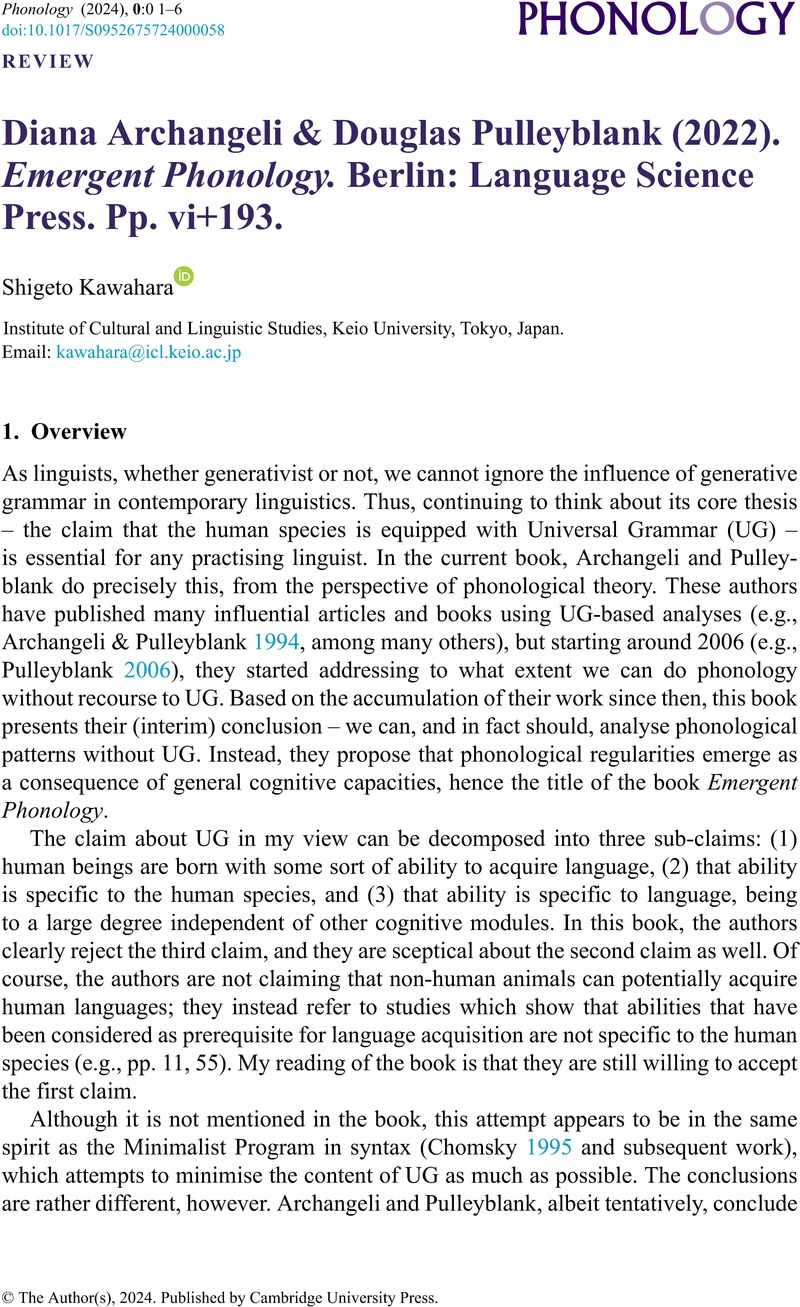No CrossRef data available.
Article contents
Diana Archangeli & Douglas Pulleyblank (2022). Emergent Phonology. Berlin: Language Science Press. Pp. vi+193.
Review products
Diana Archangeli & Douglas Pulleyblank (2022). Emergent Phonology. Berlin: Language Science Press. Pp. vi+193.
Published online by Cambridge University Press: 19 March 2024
Abstract
An abstract is not available for this content so a preview has been provided. Please use the Get access link above for information on how to access this content.

- Type
- Review
- Information
- Copyright
- © The Author(s), 2024. Published by Cambridge University Press
References
Archangeli, Diana & Pulleyblank, Douglas (1994). Grounded phonology. Cambridge, MA: MIT Press.Google Scholar
Broselow, Ellen, Chen, Su-I & Wang, Chilin (1998). The emergence of the unmarked in second language phonology. Studies in Second Language Acquisition 20, 261–280.CrossRefGoogle Scholar
Gigerenzer, Gerd & Gaissmaier, Wolfgang (2011). Heuristic decision making. Annual Review of Psychology 62, 451–482.CrossRefGoogle ScholarPubMed
Gouskova, Maria (to appear). MSCs in positional neutralisation: the problem of gapped inventories. Phonology 40.Google Scholar
Hayes, Bruce (1999). Phonetically-driven phonology: the role of Optimality Theory and inductive grounding. In Darnell, Michael, Moravscik, Edith, Noonan, Michael, Newmeyer, Frederick & Wheatly, Kathleen (eds.) Functionalism and formalism in linguistics: volume 1: general papers. Amsterdam: John Benjamins, 243–285.CrossRefGoogle Scholar
Hayes, Bruce & Wilson, Colin (2008). A maximum entropy model of phonotactics and phonotactic learning. LI 39, 379–440.Google Scholar
Holtman, Astrid (1996). A generative theory of rhyme: an Optimality approach. PhD dissertation, Utrecht Institute of Linguistics.Google Scholar
Ito, Junko & Mester, Armin (1995). Japanese phonology. In Goldsmith, John (ed.) The handbook of phonological theory. Oxford: Blackwell, 817–838.Google Scholar
McCarthy, John J. (2003). OT constraints are categorical. Phonology 20, 75–138.CrossRefGoogle Scholar
McCarthy, John J. & Prince, Alan (1994). The emergence of the unmarked: Optimality in prosodic morphology. NELS 24, 333–379.Google Scholar
McCarthy, John J. & Prince, Alan (1995). Faithfulness and reduplicative identity. University of Massachusetts Occasional Papers in Linguistics 18, 249–384.Google Scholar
Pierrehumbert, Janet B. (2001). Exemplar dynamics: word frequency, lenition and contrast. In Bybee, Joan & Hopper, Paul (eds.) Frequency and the emergence of linguistic structure, number 45 in Typological Studies in Language. Amsterdam: John Benjamins, 137–157.CrossRefGoogle Scholar
Pulleyblank, Douglas (2006). Minimizing UG: constraints upon constraints. WCCFL 25, 15–39.Google Scholar





